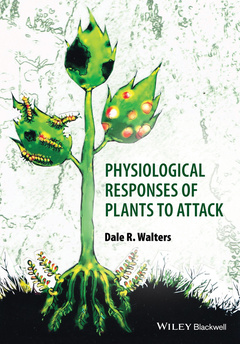Description
Physiological Responses of Plants to Attack
Author: Walters Dale
Language: English
Subjects for Physiological Responses of Plants to Attack:
Keywords
Plant science, Plant protection, Crop protection, Crops, Pests, Weeds, Diseases, Plant physiology, Plant defense, Predation
248 p. · 17.2x24.5 cm · Paperback
Description
/li>Contents
/li>Biography
/li>
Despite the research effort put into controlling pathogens, pests and parasitic plants, crop losses are still a regular feature of agriculture worldwide. This makes it important to manage the crop appropriately in order to maximise yield. Understanding the relationship between the occurrence and severity of attack, and the resulting yield loss, is an important step towards improved crop protection. Linked to this, is the need to better understand the mechanisms responsible for reductions in growth and yield in affected crops.
Physiological Responses of Plants to Attack is unique because it deals with the effects of different attackers ? pathogens, herbivores, and parasitic plants, on host processes involved in growth, reproduction, and yield. Coverage includes effects on photosynthesis, partitioning of carbohydrates, water and nutrient relations, and changes in plant growth hormones. Far from being simply a consequence of attack, the alterations in primary metabolism reflect a more dynamic and complex interaction between plant and attacker, sometimes involving re-programming of plant metabolism by the attacker.
Physiological Responses of Plants to Attack is written and designed for use by senior undergraduates and postgraduates studying agricultural sciences, applied entomology, crop protection, plant pathology and plant sciences. Biological and agricultural research scientists in the agrochemical and crop protection industries, and in academia, will find much of use in this book. All libraries in universities and research establishments where biological and agricultural sciences are studied and taught should have copies of this exciting book on their shelves
Preface xi
1 The Interaction Between a Plant and Its Attacker 1
1.1 Introduction 1
1.2 Different types of attacker 1
1.3 Symptoms exhibited by plants following attack 20
1.4 Conclusions 21
Recommended reading 21
References 22
2 Growth, Development and Yield of Infected and Infested Plants and Crops 24
2.1 Introduction 24
2.2 Effects of pathogens on growth, development and yield 24
2.3 Effects of nematodes on growth, development and yield 29
2.4 Effects of herbivores on growth, development and yield 30
2.5 Effects of parasitic plants on growth, development and yield 36
2.6 Conclusions 37
Recommended reading 38
References 38
3 Photosynthesis in Attacked Plants and Crops 41
3.1 Introduction 41
3.2 Photosynthesis in diseased plants 41
3.3 Photosynthesis in plants infected with nematodes 61
3.4 Photosynthesis in plants infested with insects 65
3.5 Photosynthesis in plants infected with parasitic plants 73
3.6 The caring robber? hardly! 80
3.7 Conclusions 81
Recommended reading 81
References 81
4 Respiration in Plants Interacting with Pathogens, Pests and Parasitic Plants 88
4.1 Introduction 88
4.2 Effects of attack on respiration 90
4.3 Photorespiration in attacked plants 105
4.4 Conclusion 108
Recommended reading 109
References 109
5 Effects on Carbohydrate Partitioning and Metabolism 114
5.1 Introduction 114
5.2 Carbohydrate partitioning and metabolism in plants infected by pathogens 114
5.3 Carbohydrate metabolism and partitioning in plant–insect herbivore interactions 122
5.4 Carbohydrate metabolism and partitioning in interactions between plants and parasitic angiosperms 124
5.5 Conclusions 125
Recommended reading 126
References 127
6 Water Relations of Plants Attacked by Pathogens, Insect Herbivores and Parasitic Plants 130
6.1 Introduction 130
6.2 Effects of pathogens on plant water relations 130
6.3 Effects of nematodes on plant water relations 139
6.4 Water relations in plants infested with insect herbivores 140
6.5 Effects of parasitic angiosperms 145
6.6 Conclusions 148
Recommended reading 149
References 149
7 Mineral Nutrition in Attacked Plants 153
7.1 Introduction 153
7.2 Mineral nutrition in plant–pathogen interactions 156
7.3 Mineral nutrition in plant–nematode interactions 164
7.4 Mineral nutrition in plant–insect interactions 165
7.5 Mineral nutrition in interactions between plants and parasitic angiosperms 170
7.6 Conclusions 175
Recommended reading 176
References 176
8 Hormonal Changes in Plants Under Attack 181
8.1 Introduction 181
8.2 Hormonal changes in plants responding to pathogens 181
8.3 Hormonal changes in plants responding to insect attack 198
8.4 Hormonal changes in plants infected with parasitic plants 201
8.5 Conclusions 205
Recommended reading 207
References 207
9 Bringing It Together: Physiology and Metabolism of the Attacked Plant 215
9.1 Introduction 215
9.2 Metabolic reprogramming in plant–pathogen interactions 215
9.3 Metabolic reprogramming in interactions between plant and parasitic nematodes 220
9.4 Metabolic reprogramming in plant–insect interactions 221
9.5 Metabolic reprogramming in interactions between plants and parasitic angiosperms 222
9.6 Metabolic reprogramming – is the plant just a bystander in compatible interactions? 222
9.7 Plant responses to attack – a look to the future 222
Recommended reading 223
References 223
Index 225




